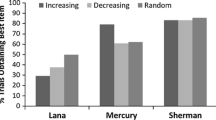Abstract
Self-control has been studied in nonhuman animals using a variety of tasks. The inter-temporal choice (ITC) task presents choices between smaller–sooner (SS) and larger–later (LL) options. Using food amounts as rewards, this presents two problems: (a) choices of the LL option could either reflect self-control or instead result from animals’ difficulty with pointing to smaller amounts of food; (b) there is no way to verify whether the subjects would not revert their choice for the LL option, if given the opportunity to do so during the ensuing delay. To address these problems, we have recently introduced a new protocol, the hybrid delay task, which combines an initial ITC with a subsequent accumulation phase in which selection of the SS option leads to its immediate delivery, but choice of the LL option then leads to one-by-one presentation of those items that continues only as long as the subject does not eat any of the accumulated items. The choice of the LL option therefore only reflects self-control when the number of items obtained from LL choices during the accumulation phase is higher than what could be received in the SS option. Previous research with capuchin monkeys demonstrated that their apparent self-control responses in the ITC task may have overestimated their general self-control abilities, given their poor performance in the hybrid delay task. Here, chimpanzees instead demonstrated that their choices for the LL option in the ITC phase of the hybrid delay task were confirmed by their ability to sustain long delays during accumulation of LL rewards.
Similar content being viewed by others
References
Abramson JZ, Hernandez-Lloreda V, Call J, Colmenares F (2011) Relative quantity judgments in South American sea lions (Otaria flavescens). Anim Cogn 14:695–706
Addessi E, Paglieri F, Focaroli V (2011) The ecological rationality of delay tolerance: insights from capuchin monkeys. Cognition 119:142–147
Addessi E, Paglieri F, Beran M, Evans T, Macchitella L, De Petrillo F, Focaroli V (2013) Delay choice vs. delay maintenance: different measures of delayed gratification in capuchin monkeys (Cebus apella). J Comp Psychol [Epub ahead of print]
Ainslie GW (1974) Impulse control in pigeons. J Exp Anal Behav 21:485–489
Anderson JR, Kuroshima H, Fujita K (2010) Delay of gratification in capuchin monkeys (Cebus apella) and squirrel monkeys (Saimiri sciureus). J Comp Psychol 124:205–210
Auersperg AMI, Laumer IB, Bugnyar T (2013) Goffin cockatoos wait for qualitative and quantitative gains but prefer ‘better’ to ‘more’. Biol Lett 9(3):20121092
Baumeister RF, Vohs KD (eds) (2004) Handbook of self-regulation: research, theory, and applications. Guilford Press, New York
Beran MJ (2001) Summation and numerousness judgments of sequentially presented sets of items by chimpanzees (Pan troglodytes). J Comp Psychol 115:181–191
Beran MJ (2002) Maintenance of self-imposed delay of gratification by four chimpanzees (Pan troglodytes) and an orangutan (Pongo pygmaeus). J Gen Psychol 129:49–66
Beran MJ (2004) Chimpanzees (Pan troglodytes) respond to nonvisible sets after one-by-one addition and removal of items. J Comp Psychol 118:25–36
Beran MJ, Evans TA (2006) Maintenance of delay of gratification by four chimpanzees (Pan troglodytes): the effects of delayed reward visibility, experimenter presence, and extended delay intervals. Behav Process 73:315–324
Beran MJ, Savage-Rumbaugh ES, Pate JL, Rumbaugh DM (1999) Delay of gratification in chimpanzees (Pan troglodytes). Dev Psychobiol 34:119–127
Beran MJ, Evans TA, Hoyle D (2011) Numerical judgments by chimpanzees (Pan troglodytes) in a token economy. J Exp Psychol Anim Behav Proc 37:165–174
Boysen ST, Berntson GG (1995) Responses to quantity: perceptual versus cognitive mechanisms in chimpanzees (Pan troglodytes). J Exp Psychol Anim Behav Proc 21:82–86
Chelonis JJ, King G, Logue AW, Tobin H (1994) The effect of variable delays on self-control. J Exp Anal Behav 62:33–43
Cheng K, Pena J, Porter MA, Irwin JD (2002) Self-control in honeybees. Psych Bull Rev 9:259–263
Dufour V, Pelé M, Sterck EHM, Thierry B (2007) Chimpanzee (Pan troglodytes) anticipation of food return: coping with waiting time in an exchange task. J Comp Psychol 121:145–155
Dufour V, Wascher CAF, Braun A, Miller R, Bugnyar T (2012) Corvids can decide if a future exchange is worth waiting for. Bio Lett 8:201–204
Evans TA, Beran MJ (2007) Chimpanzees use self-distraction to cope with impulsivity. Biol Lett 3:599–602
Evans TA, Westergaard GC (2006) Self-control and tool use in tufted capuchin monkeys (Cebus apella). J Comp Psychol 120:163–166
Evans TA, Beran MJ, Harris EH, Rice D (2009) Quantity judgments of sequentially presented food items by capuchin monkeys (Cebus apella). Anim Cogn 12:97–105
Evans TA, Beran MJ, Paglieri F, Addessi E (2012) Delaying gratification for food and tokens in capuchin monkeys (Cebus apella) and chimpanzees (Pan troglodytes): when quantity is salient, symbolic stimuli do not improve performance. Anim Cogn 15:539–548
Genty E, Karpel H, Silberberg A (2012) Time preferences in long-tailed macaques (Macaca fascicularis) and humans (Homo sapiens). Anim Cogn 15:1161–1172
Green L, Estle SJ (2003) Preference reversals with food and water reinforcers in rats. J Exp Anal Behav 79:233–242
Green L, Fry AF, Myerson J (1994) Discounting of delayed rewards: a life-span comparison. Psychol Sci 51:33–36
Grosch J, Neuringer A (1981) Self-control in pigeons under the Mischel paradigm. J Exp Anal Behav 35:3–21
Hanus D, Call J (2007) Discrete quantity judgments in the great apes (Pan paniscus, Pan troglodytes, Gorilla gorilla, Pongo pygmaeus): the effect of presenting whole sets versus item-by-item. J Comp Psychol 121:241–249
Lawyer SR, Williams SA, Prihodova T, Rollins JD, Lester AC (2010) Probability and delay discounting of hypothetical sexual outcomes. Behav Proc 84:687–692
Leavens DA, Hopkins WD (1998) Intentional communication by chimpanzee (Pan troglodytes): a cross-sectional study of the use of referential gestures. Dev Psychol 34:813–822
Leavens DA, Hopkins WD, Thomas R (2004a) Referential communication by chimpanzees (Pan troglodytes). J Comp Psychol 118:48–57
Leavens DA, Hostetter AB, Wesley MJ, Hopkins WD (2004b) Tactical use of unimodal and bimodal communication by chimpanzees, Pan troglodytes. Anim Behav 67:467–476
Logue AW (1988) Research on self-control: an integrating framework. Behav Brain Sci 11:665–709
Logue AW, Peña-Correal TE (1985) The effect of food deprivation on self control. Behav Proc 10:355–368
Logue AW, Forzano LB, Ackerman KT (1996) Self-control in children: age, preference for reinforcer amount and delay, and language ability. Learn Motiv 27:260–277
Mazur JE (2007) Species differences between rats and pigeons in choices with probabilistic and delayed reinforcers. Behav Proc 75:220–224
Mischel W (1974) Processes in delay of gratification. In: Berkowitz L (ed) Advances in experimental social psychology. Academic Press, New York, pp 249–292
Mischel W (1981) Objective and subjective rules for delay of gratification. In: d’Ydewalle G, Lens W (eds) Cognition in human learning and motivation. Erlbaum, Hillsdale, NJ, pp 33–58
Mischel W, Shoda Y, Rodriguez ML (1989) Delay of gratification in children. Science 244:933–938
Paglieri F, Focaroli V, Bramlett J, Tierno V, McIntyre J, Addessi E, Evans TA, Beran MJ (2013) The hybrid delay task: can capuchin monkeys (Cebus apella) sustain a delay after an initial choice to do so. Behav Proc 94:45–54
Pele M, Dufour V, Micheletta J, Thierry B (2010) Long-tailed macaques display unexpected waiting abilities in exchange tasks. Anim Cogn 13:263–271
Pelé M, Micheletta J, Uhlrich P, Thierry B, Dufour V (2011) Delay maintenance in tonkean macaques (Macaca tonkeana) and brown capuchin monkeys (Cebus apella). Int J Primatol 32:149–166
Perdue BM, Talbot CG, Stone AM, Beran MJ (2012) Putting the elephant back in the herd: elephant relative quantity judgments match those of other species. Anim Cogn 15:955–961
Rachlin H (1995) Self-control: beyond commitment. Behav Brain Sci 18:109–159
Rachlin H, Green L (1972) Commitment, choice, and self-control. J Exp Anal Behav 17:15–22
Rosati AG, Stevens JR, Hare B, Hauser MD (2007) The evolutionary origins of human patience: temporal preferences in chimpanzees, bonobos, and human adults. Curr Biol 17:1663–1668
Rumbaugh DM (1977) Language learning by a chimpanzee: the LANA project. Academic Press, New York
Rumbaugh DM, Washburn DA (2003) Intelligence of apes and other rational beings. Yale University Press, New Haven
Russell JL, Lyn H, Schaeffer JA, Hopkins WD (2011) The role of socio-communicative rearing environments in the development of social and physical cognition in apes. Dev Sci 14:1459–1470
Savage-Rumbaugh ES (1986) Ape language: from conditioned response to symbol. Columbia University Press, New York
Shifferman EM (2009) Its own reward: lessons to be drawn from the reversed-reward contingency paradigm. Anim Cogn 12:547–558
Stevens JR, Mühlhoff N (2012) Intertemporal choice in lemurs. Behav Proc 89:121–127
Stevens JR, Hallinan EV, Hauser MD (2005a) The ecology and evolution of patience in two New World monkeys. Biol Letters 1:223–226
Stevens JR, Rosati AG, Ross KR, Hauser MD (2005b) Will travel for food: spatial discounting in two New World monkeys. Curr Biol 15:1855–1860
Stevens JR, Rosati AG, Heilbronner SR, Mühlhoff N (2011) Waiting for grapes: expectancy and delayed gratification in bonobos. Int J Comp Psychol 24:99–111
Tangney JP, Baumeister RF, Boone AL (2004) High self-control predicts good adjustment, less pathology, better grades, and interpersonal success. J Pers 72:271–324
Tobin H, Chelonis JJ, Logue AW (1993) Choice in self-control paradigms using rats. Psychol Rec 43:441–454
Tobin H, Logue AW, Chelonis JJ, Ackerman KT, May JG (1996) Self-control in the monkey Macaca fascicularis. Anim Learn Behav 24:168–174
Toner IJ, Smith RA (1977) Age and overt verbalization in delay-maintenance behavior in children. J Exp Child Psychol 24:123–128
Uller C, Jaeger R, Guidry G, Martin C (2003) Salamanders (Plethodon cinereus) go for more: rudiments of number in an amphibian. Anim Cogn 6:105–112
van Haaren F, van Hest A, Van de Poll NE (1988) Self-control in male and female rats. J Exp Anal Behav 49:201–211
Vick SJ, Bovet D, Anderson JR (2010) How do African grey parrots (Psittacus erithacus) perform on a delay of gratification task? Anim Cogn 13:351–358
White JL, Moffitt TE, Caspi A, Bartusch DJ, Needles DJ, Stouthamer-Loeber M (1994) Measuring impulsivity and examining its relationship to delinquency. J Abnorm Psychol 103:192–205
Acknowledgments
This research was supported by National Institutes of Health Grant HD060563. All aspects of this research conformed to APA standards for the ethical treatment of animals and followed the Institute of Science guidelines for ethical research with chimpanzees.
Conflict of interest
The authors declare that they have no conflicts of interest.
Author information
Authors and Affiliations
Corresponding author
Rights and permissions
About this article
Cite this article
Beran, M.J., Evans, T.A., Paglieri, F. et al. Chimpanzees (Pan troglodytes) can wait, when they choose to: a study with the hybrid delay task. Anim Cogn 17, 197–205 (2014). https://doi.org/10.1007/s10071-013-0652-9
Received:
Revised:
Accepted:
Published:
Issue Date:
DOI: https://doi.org/10.1007/s10071-013-0652-9




